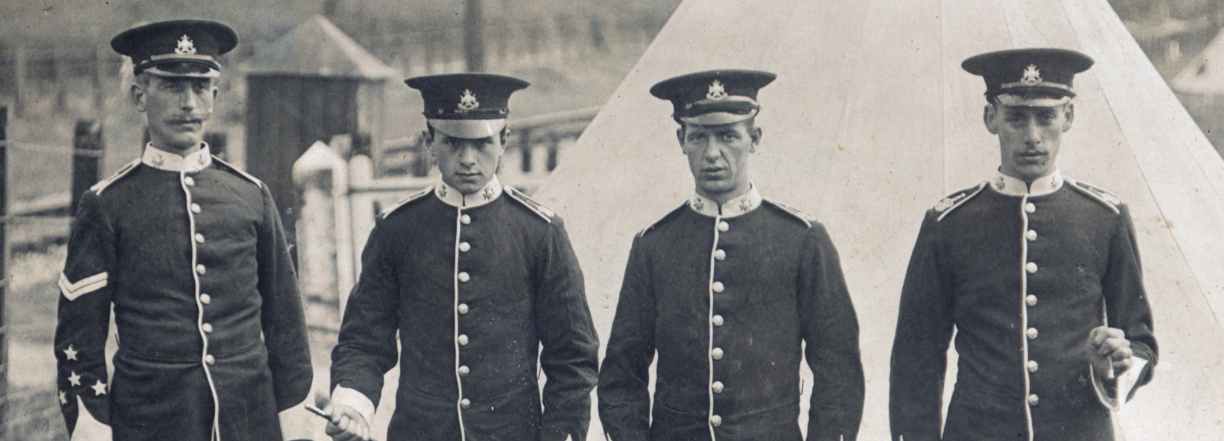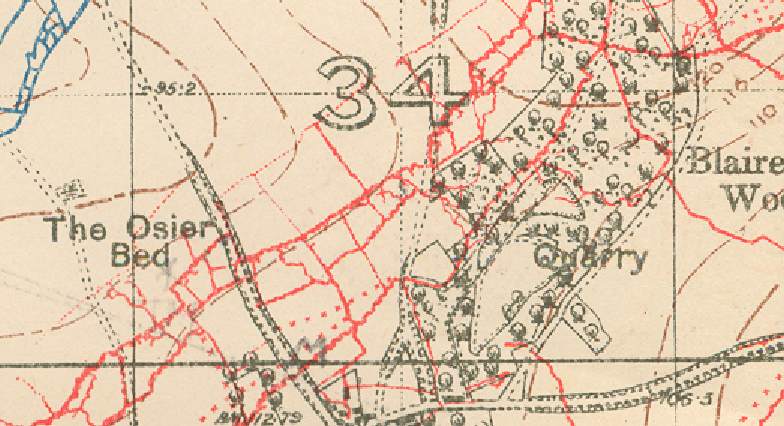 “The German lines opposite this sector possessed two features of particular interest in the ‘Blockhouse’, a strongly defended salient, and the ‘Talus’, a machine-gun post pushed some 200 yards forward of their main line in a hillside embankment. Two sunken roads and a watercourse in No Man’s Land added to the interest of life and provided our patrols with some useful work.”
“The German lines opposite this sector possessed two features of particular interest in the ‘Blockhouse’, a strongly defended salient, and the ‘Talus’, a machine-gun post pushed some 200 yards forward of their main line in a hillside embankment. Two sunken roads and a watercourse in No Man’s Land added to the interest of life and provided our patrols with some useful work.”
[The War History of the 4th Battalion, the London Regiment (Royal Fusiliers), 1914-1919]
“The Bellacourt sector was an extremely quiet sector and reliefs were able to be undertaken in broad daylight. No Mans land consisted of shallow depressions densely packed with barbed wire and the nearest German post was the head of a sap known as the Talus.”
[The 17th (Service) Battalion Manchester Regiment; 2nd City Pals Battalion]
 “In advance of the enemy’s main line and lying in a hallow screened from direct observation, is a bank (or sunken fence) 200 yards long, known as the TALUS (see plan below).
“In advance of the enemy’s main line and lying in a hallow screened from direct observation, is a bank (or sunken fence) 200 yards long, known as the TALUS (see plan below).
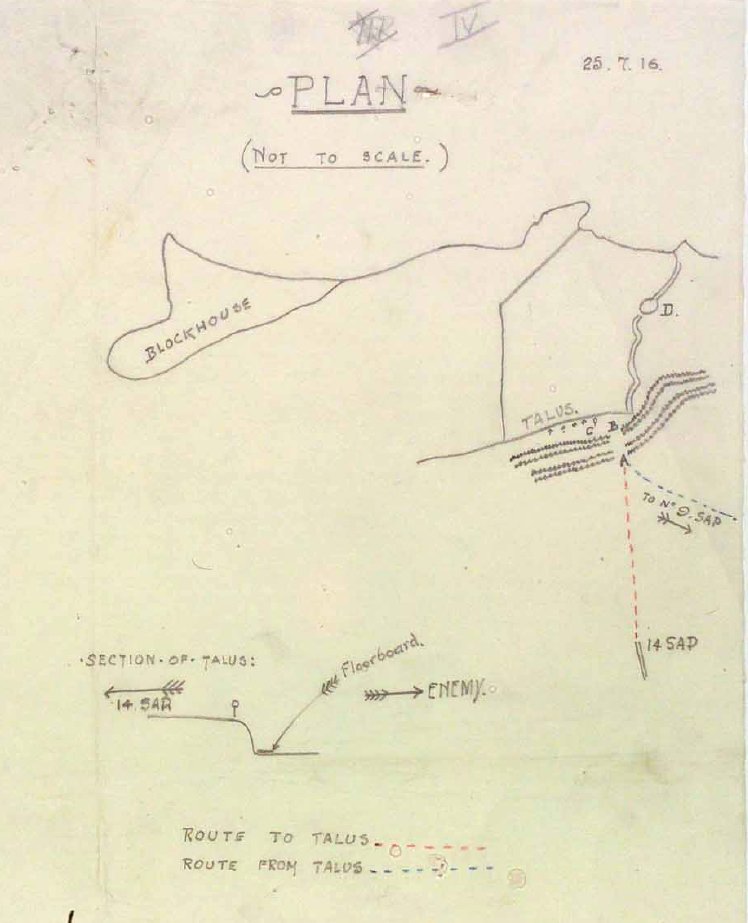 This bank is 200 yards distant from No 14 SAP and rather more from No 15, from which saps it is approached by a downward slope, devoid of cover. The TALUS is connected at its SOUTH end with enemy’s front line by a C.T. some 200 yards long. About 120 yards down this C.T. is a circular work probably a Machine Gun dug-out or emplacement marked “D”. In front of the TALUS are two depths of wire, each about 10 yards deep with an interval between them of some 10 yards. At a point apparently 15 yards from SOUTH end of TALUS is a gap 10 to 15 yards wide (marked A – B on plan) Both sides of the C.T. are strongly wired and there is also much wire between the TALUS and the enemy’s front trench, and on the NORTH (open) flank which latter is protected by the BLOCKHOUSE. Apparently it is the enemy’s custom to patrol the TALUS from time to time. His patrols also use the gap A-B to approach our line, and there is often a working party on the wire in the neighbourhood.”
This bank is 200 yards distant from No 14 SAP and rather more from No 15, from which saps it is approached by a downward slope, devoid of cover. The TALUS is connected at its SOUTH end with enemy’s front line by a C.T. some 200 yards long. About 120 yards down this C.T. is a circular work probably a Machine Gun dug-out or emplacement marked “D”. In front of the TALUS are two depths of wire, each about 10 yards deep with an interval between them of some 10 yards. At a point apparently 15 yards from SOUTH end of TALUS is a gap 10 to 15 yards wide (marked A – B on plan) Both sides of the C.T. are strongly wired and there is also much wire between the TALUS and the enemy’s front trench, and on the NORTH (open) flank which latter is protected by the BLOCKHOUSE. Apparently it is the enemy’s custom to patrol the TALUS from time to time. His patrols also use the gap A-B to approach our line, and there is often a working party on the wire in the neighbourhood.”
A raid by the 1/6th Battalion Sherwood Foresters on 17th July 1916

During the evening of the 17th July the Talus was reconnoitred for the first time by a patrol led by 2/Lt Edward Kershaw. Following this patrol it was decided that the next time the Battalion held the front line a raid would be made on the German position. Later during the evening the Battalion were relieved by the 5th Sherwood Foresters and moved into Brigade reserve in the village of Bellacourt, with the exception of A Company, which remained in support of the 5th Sherwood Foresters. At this time the Battalion also supplied garrisons for Boundary Burnt Farm, Starfish and Orchard Posts.
 Private 1487 George Pratt of Brimington was the only man to be killed during this trench duty and was the first man of the 6th Sherwood Foresters to be buried in Bellacourt Military Cemetery, which was to act as the Cemetery for the whole time that battalion where in the front-line area.
Private 1487 George Pratt of Brimington was the only man to be killed during this trench duty and was the first man of the 6th Sherwood Foresters to be buried in Bellacourt Military Cemetery, which was to act as the Cemetery for the whole time that battalion where in the front-line area.
Wednesday 23rd July 1916
On Wednesday 23rd August the battalion moved into the front line trenches for their second trench tour of this sector and plans were put in place for a raid in strength on the talus.
Thursday 24th July 1916
During the evening of 24th July a patrol comprising 2/Lt Edward Kershaw, 2/Lt Frederick Oliver and 2 other ranks penetrated the gap in the Talus wire and lay on the bank facing the enemy.
 Whilst in this position the raiding party was challenged by a German patrol that fired upon them, severely wounding Frederick Oliver, and following the withdrawal of the patrol it was discovered that 3152 Pte. Frank Webb was missing.
Whilst in this position the raiding party was challenged by a German patrol that fired upon them, severely wounding Frederick Oliver, and following the withdrawal of the patrol it was discovered that 3152 Pte. Frank Webb was missing.
 The bodies of Frederick Oliver and Frank Webb were not recovered after the War and their names are commemorated on the Thiepval and Arras Memorials respectively.
The bodies of Frederick Oliver and Frank Webb were not recovered after the War and their names are commemorated on the Thiepval and Arras Memorials respectively.
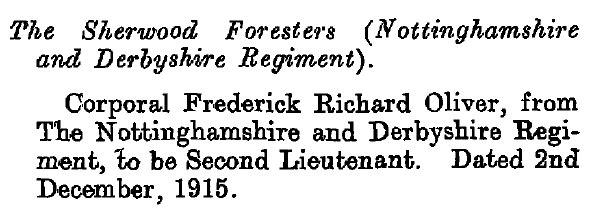 Frederick Richard Oliver was Commissioned into the Sherwood Foresters in February 1915 but his Officer Service Record does not appear to be available.
Frederick Richard Oliver was Commissioned into the Sherwood Foresters in February 1915 but his Officer Service Record does not appear to be available.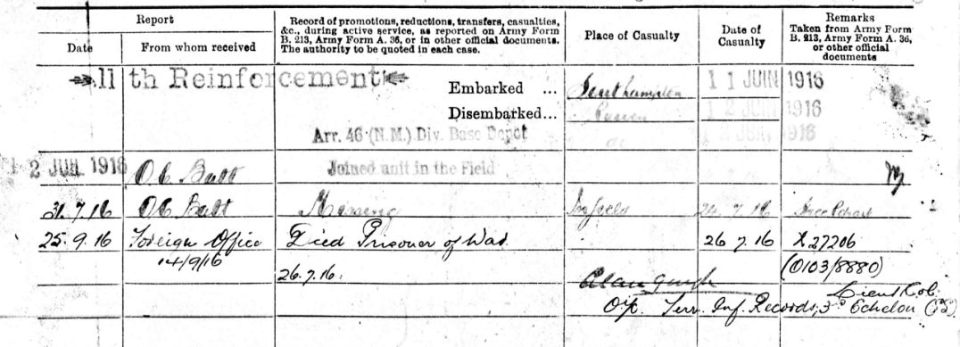
Franks Webb’s Army Service Record states that he was made prisoner of war, but died of his wounds on the 26th July.
During such raids on the enemy trenches men of the attacking party removed all forms of identification, therefore even if the Germans had recovered the bodies both of Frederick Oliver and Frank Webb they would not have been able to identify them for burial.
Monday 28th July 1916
A raid in strength was organised for the night of the 28th July for the purpose of taking prisoners, securing identification, taking any machine guns at position “D” and for inflicting as much damage as possible on the enemy. The raiding party, which was under the command of 2/Lt Richard Evans consisted of 20 NCOs and men from B Company, with a section of 6 bombers. The raiding party was divided into 4 sections:-
1) A blocking party of 2 bombers (with 1 N.C.O) and 2 men
2) 1 N.C.O. 2 bombers and 2 men
3) 1 Officer, 1 N.C.O., 11 men and 1 Royal Engineer carrying explosives
4) 1 N.C.O., 2 bombers and 1 man
Each member of the raiding party was instructed to carry 10 rounds in pocket magazines and 2 bombs in addition to their usual equipment. All badges and marks of identification were removed and socks were pulled over their boots.
At 10.30pm Edward Kershaw and seven scouts left No. 15 SAP taking a reel of tape, one end of which was tied to a stake. This party proceeded ahead to reconnoitre the TALUS and find a gap in the wire.
At 11.50pm 2 scouts returned to the SAP and took 2/Lt Richard Evans and his party out in to no-mans-land. By following the tape this party joined with the scouts at 12.15am and then passed through the gap in the wire and on into the TALUS. The blocking party moved to the bush on the left while the scouts remained on the bank.
Evans and his party set out along the TALUS but found his way blocked by 2 separate lines of barbed wire, which stretched from the German front line to the TALUS.
The raiding party crossed this wire and proceeded 100 yards towards the enemy SAP. However he was unable to locate the SAP and decided to return with his party to the TALUS. During this time bullets (apparently un-aimed) were striking the bank from the German front line.
After arriving at the TALUS the raiding party returned to the British Front line via No. 9 SAP, however as the party were approaching this SAP, 1 N.C.O and 1 man were wounded. Although no prisoners were taken the Commander of the 46th Division sent a congratulatory telegram to all those involved.
The Battalion were relived by the 5th Sherwood Foresters during the evening of the 29th July and moved into billets in Bailleulval, where a draft of 59 men arrived the following day.
For his part in this raid 3234 Lance Corporal Ernest Munday was awarded the Military Medal:-
‘For his gallantry and good work when part of a party detailed to carry out a raid on talus (the German lines) near Bellacourt on the night of 28th/29th July 1916’.
[London Gazette 11.11.1916]
A raid by “B” Company, the 1/5th Sherwood Foresters
Official Operation Orders 77 Operations Orders 77 from WO-95-2692-6
24th 7am: A patrol of 5th Sherwood Foresters found that the wire in the bed of the river under the BLOCKHOUSE was intact.
 24th 7.30pm: “A” PARTY under Lieut SANDOVER left our front line near the top of WILLOWS and reached the enemys wire under the BLOCKHOUSE forty minutes later.
24th 7.30pm: “A” PARTY under Lieut SANDOVER left our front line near the top of WILLOWS and reached the enemys wire under the BLOCKHOUSE forty minutes later.
At 8.30pm Lieut SMALLEY with 8 men and a Lewis Gun “B” PARTY left our trenches and took up their position in the RAVINE in support of the first party.
Lieutenant SANDOVER hearing a party working to his right front endeavoured to find a gap in the German wire between the RAVINE and the BLOCKHOUSE. After passing through two rows of wire he and Sgt LOOMES were cutting through a third row when they were challenged by the enemy’s sentry 15 yards from them who threw four hand grenades. Finding it was impossible to surprise the enemy’s post Lieut. SANDOVER ordered his party to withdraw. In the meantime Rifle and Machine Gun fire had been opened from the German trench & Cpl JOHNSON was hit in the head. Lieutenant SANDERSON dragged the Corporal through the wire with the assistance of Pte MARRIOTT who had returned to help him & the whole party gained the cover of the river bed without further casualties.
Supporting fire was soon afterwards opened by our Artillery who carried out the remained of the programme very effectively. On the guns opening fire Stokes Mortars and Rifle Grenades were fired from CAVENDISH SAP into the German Saps & Trenches in X3b, the enemy replying with 20 HE shells on left sector.
The Officers leading this raid were:-
- Alfred Eric Sandover
- Edward Arthur Victor SmalleySmalley
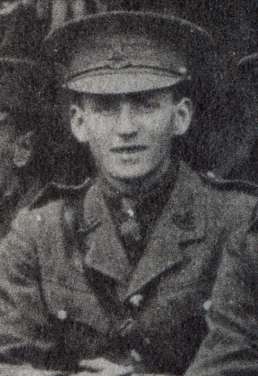 Edward Arthur Victor Smalley (1885-)
Edward Arthur Victor Smalley (1885-)
The NCOs and Other Ranks mentioned in the War Diary were:-
20636/203482 Sergeant Christoper Loomes a Pre-War Regular of the 2nd Battalion who was attached to the 1/5th Battalion on 6th July 1916.20636 Loomes
3944 Corporal Robert William Edward Johnson who died of his wounds aged 19 and is buried in Bellacourt Military Cemetery. Robert was the son of Robert Eilliam and Harriett Johnson of 19 Nuttall St. in Alfreton, Derbyshire. He was a native of Huthwaite in Nottsinghamshire. He is Commemorated on the Huthwaite and Alfreton Memorials.
2584 Pte Fred Marriott who won the Military Medal (London Gazette 11th November 1916).
